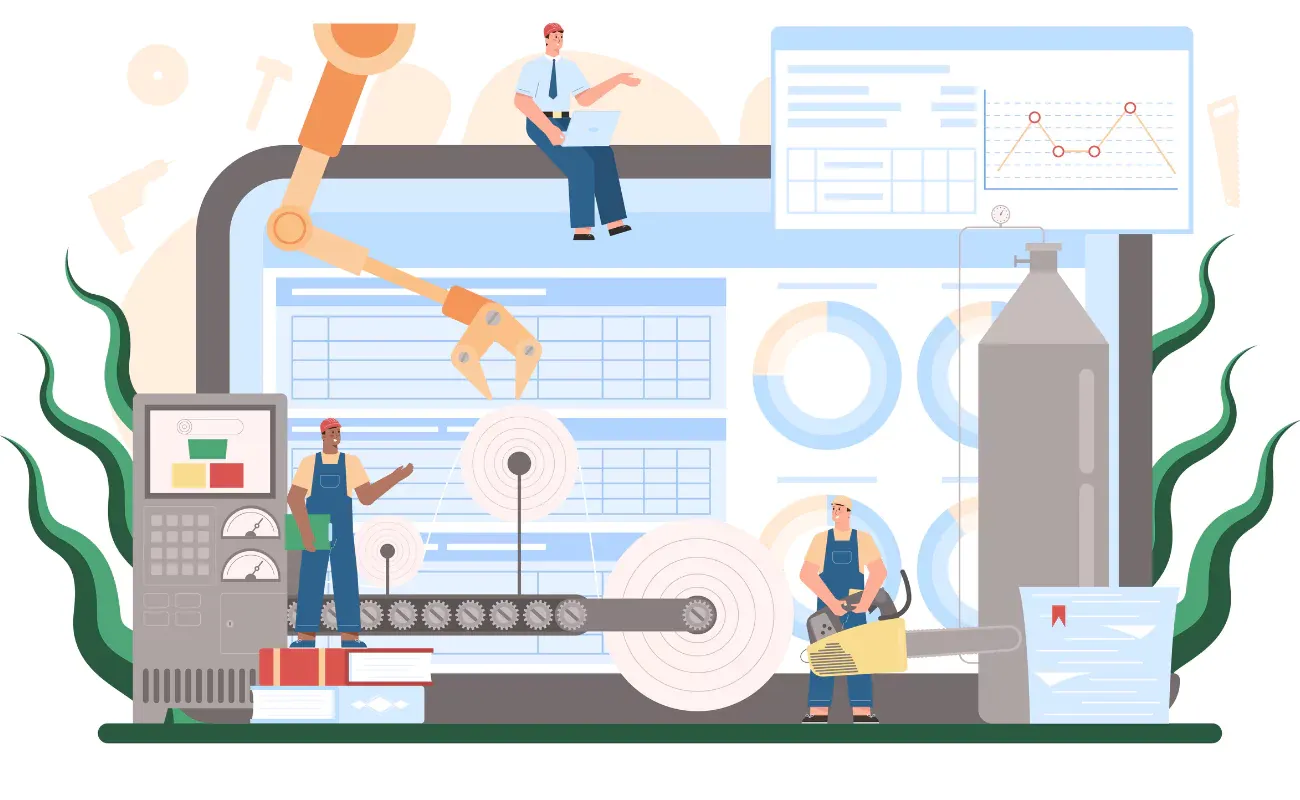The world of data analysis is changing rapidly, and Machine Learning (ML) is at the forefront of this revolution. But what if you lack the extensive technical expertise to leverage ML's power? Enter Machine Learning as a Service (MLaaS)!
This article will help you understand MLaaS, its benefits, and how it can unlock valuable insights from your data, whether you're a complete beginner or have some experience. Let's unlock the potential of MLaaS together!
>> Read more:
- What is SaaS? Guide for SaaS Application Development
- SaaS Application Development Company: Top Choices for Your Project
What is Machine Learning as a Service (MLaaS)?
Machine Learning as a Service (MLaaS) is essentially renting access to the tools and infrastructure needed to leverage machine learning (ML) capabilities. Imagine it like this:
-
Traditional Machine Learning: Building your own powerful race car from scratch - requires extensive knowledge, expensive parts, and a dedicated pit crew (technical expertise and infrastructure).
-
Machine Learning as a Service: Renting a pre-built race car on a track (cloud platform) - you choose the destination (your specific needs) and focus on driving (using the model), while the service provider maintains the car and track (infrastructure management).

How Does MLaas Work?
Here's a breakdown of how MLaaS works:
Step 1: Model Training
You provide your data to the MLaaS platform. This data could be anything from customer purchase history to sensor readings from machines. The platform then uses various machine learning algorithms to "train" a model based on your data. Think of this model as a learning tool that can identify patterns and make predictions based on your data.
Step 2: Deployment
After the model is trained, you can deploy it on the MLaaS platform. This means making it available for use. Imagine deploying your trained model like publishing a new software program.
Step 3: Infrastructure Management
One of the biggest advantages of MLaaS is that it takes care of the heavy lifting involved in running machine learning models. You don't need to worry about purchasing expensive computers or servers to train and run your models. The MLaaS provider handles all the underlying infrastructure needs.
Step 4: API Access
MLaaS platforms typically provide access through APIs. An API acts like a middleman between your application and the machine learning model. You can send your data through the API to the model, and the model will send predictions or analysis back to your application.
Benefits of Using Machine Learning as a Service (MLaaS)
Running the whole life cycle of your own machine learning infrastructure can be a daunting task. Fortunately, MLaaS can be a compelling option for businesses of all sizes because of some following advantages:
Scalability
MLaaS platforms are designed to be highly scalable. You can easily increase or decrease the computing power your machine learning models as your needs change. This flexibility is much harder to achieve with an in-house infrastructure.
For example: A social media platform uses MLaaS to power its content recommendation engine. Initially, it has a small user base, so the MLaaS platform allocates a moderate computing power for training and running the recommendation model. As its user base dramatically grows, it can quickly scale up its MLaaS resources to process the massive amount of data.
Cost-Efficiency
Operating an in-house ML infrastructure requires a significant upfront investment in hardware, software, and skilled personnel. MLaaS eliminates this need. You only pay for the resources you use, making it a much more cost-effective solution for most businesses.
For example: A small healthcare startup wants to use ML to analyze medical images for early detection of diseases. Building their own infrastructure would be prohibitively expensive. MLaaS using a pay-as-you-go model allows them to access the powerful computing resources without breaking the bank.
Faster Time-to-Market
Developing and deploying in-house ML models can be a time-consuming process. MLaaS platforms provide pre-built tools and templates to speed up development. This allows businesses to launch machine learning projects faster and get results sooner.
For example: A manufacturing company wants to implement a predictive maintenance system to prevent equipment failures. MLaaS lets them leverage pre-built algorithms for anomaly detection and deploy the system quickly. This helps them avoid costly downtime and maintain optimal production levels.
>> Read more: Top 7 Machine Learning Solutions For Growing Your Business
Exploring MLaaS Applications Across Different Industries
MLaaS applications increasingly extend and transform various industries with the power of machine learning. Let's delve into some exciting use cases:
Predictive Maintenance (Manufacturing)
In case of an active factory, every machine plays a critical role in the production process. Downtime due to unexpected equipment failures can be incredibly costly, leading to production delays, lost revenue, increased repair costs, and working safety risks.
Fortunately, MLaaS can be an effective solution. By analyzing sensor data from machines, MLaaS models can predict potential failures before they occur. This allows for proactive maintenance, minimizing downtime and maximizing production efficiency.
Example: A large wind turbine manufacturer uses MLaaS to analyze sensor data from wind turbines. The model identifies early signs of bearing wear, enabling technicians to schedule maintenance before a catastrophic failure. This prevents costly repairs, lost energy production, and potential safety risks.

Fraud Detection (Finance)
Financial institutions handle a massive flow of transactions daily, making them prime targets for fraudsters. As fraudsters are constantly evolving their tactics, traditional methods with simple rules no longer work.
Instead, MLaaS plays a critical role as a safeguard for these institutions and their customers. MLaaS empowers financial institutions with advanced machine learning models trained on vast datasets of historical transactions, both fraudulent and legitimate. These models can analyze complex patterns and discover anomalies that humans may miss.
Example: An online banking platform uses MLaaS to analyze transactions. Unusual spending patterns or login attempts from unfamiliar locations are detected by the model. This allows the bank to immediately take action for consumer account protection.
Customer Churn Prediction (Telecom & Retail)
Losing customers can be detrimental to any business. MLaaS helps predict customer churn, allowing companies to take proactive measures to retain their valuable customers. By analyzing customer behavior data, MLaaS models can identify customers at risk of churning.
Example: Imagine you run a popular online movie streaming service. Happy customers are the lifeblood of your business, but keeping them subscribed can be a challenge. Fortunately, MLaaS can help you based on the customer databases you provide like viewing habits, account details, etc.
Once trained, the model can give you a valuable customer heads-up on the likelihood of churn or switching to a competitor. Armed with this information, you can proactively reach out to these customers and address their concerns, or offer promotions and loyalty programs to retain them.
Image Recognition (Healthcare & Security)
MLaaS is revolutionizing medical image analysis. Machine learning models trained on vast datasets can identify abnormalities in X-rays, MRIs, and other medical images with high accuracy. This can assist doctors in early diagnosis and treatment planning.
In the realm of security, MLaaS can analyze video footage from security cameras to detect suspicious activities or identify potential security threats.
For example: An airport security system analyzes footage from security checkpoints using MLaaS. The model can detect unattended luggage and questionable behavior, allowing security personnel to act quickly.

Technical Considerations of MLaaS
While MLaaS offers a user-friendly interface, understanding some technical aspects can be beneficial for intermediate users, developers, and machine learning engineers. Let's explore a few key points:
Supported Machine Learning Algorithms
MLaaS platforms typically support a wide range of popular machine learning algorithms, including:
-
Supervised Learning: Algorithms like linear regression, decision trees, and support vector machines (SVMs) are commonly used for tasks like customer churn prediction or fraud detection.
-
Unsupervised Learning: Clustering algorithms like k-means clustering can be used for customer segmentation or anomaly detection.
-
Deep Learning: Deep neural networks are becoming increasingly popular for tasks like image recognition or natural language processing (NLP).
The specific algorithms available on an MLaaS platform will vary depending on the provider.
Model Deployment Options
Once you've trained your model, MLaaS platforms offer several options for deployment:
-
APIs (Application Programming Interfaces): APIs provide a programmatic way for your applications to interact with the trained model. You send data through the API, and the API returns the model's predictions.
-
Containers: Containerization technologies like Docker allow you to package your model and its dependencies into a self-contained unit. This simplifies deployment and ensures consistent behavior across different environments.
The choice of deployment option depends on your specific needs and the capabilities offered by your chosen MLaaS platform.
Security Considerations in MLaaS Deployments
Security is paramount when dealing with sensitive data and models. Here are some key considerations for MLaaS deployments:
-
Data Security: Ensure the MLaaS provider offers robust security measures to protect your data, both at rest and in transit. Look for features like encryption and access controls.
-
Model Security: Be mindful of potential vulnerabilities in your machine-learning model. Techniques like adversarial attacks can exploit weaknesses in the model. Consider employing security testing tools for your models.
-
Compliance: If your application handles sensitive data, ensure the MLaaS platform complies with relevant regulations like GDPR or HIPAA.
By understanding these technical considerations, you can leverage MLaaS effectively while maintaining the security of your data and models.
How to Choose The Right MLaaS Provider?
Choosing an MLaaS provider can be difficult with so many options. Here are important considerations:
Pricing Structure
There are various pricing models, including:
-
Pay-as-you-go: This model charges based on the resources you use, ideal for projects with fluctuating workloads.
-
Subscription-based: A fixed monthly cost for a set amount of resources.
-
Spot pricing: This model lets you leverage unused computing resources at a discounted rate, suitable for non-urgent tasks.
Evaluate your project requirements and budget to determine the most cost-effective pricing model.
Supported Tools and Frameworks
Different MLaaS platforms support various machine learning tools and frameworks like TensorFlow, PyTorch, or scikit-learn. Choose a provider that aligns with your preferred tools and ensures you can leverage existing code or libraries.
Scalability Options
As your project grows, your machine learning needs might evolve. Ensure the MLaaS platform offers seamless scaling options to accommodate increasing data volumes or computational demands.
Ease of Use
Consider your technical expertise and the complexity of your project. Some MLaaS platforms offer user-friendly interfaces with drag-and-drop functionalities, while others cater to experienced developers with more granular control.
Additional Features
Look for additional features that enhance your workflow, such as pre-built models, data visualization tools, or collaboration features for your team.
>> Read more about AI-related topics:
- Top 17 Best AI Apps For Individuals and Businesses
- Top 12 Best Free AI Chatbots for Businesses
- Top 10 Best AI Development Tools for Software Developers
- What is Generative AI? 5 Best Generative AI Tools
- Unlock Your Potential: Powerful ChatGPT Use Cases Explained
Conclusion
MLaaS is not just a trend, but a fundamental shift in how businesses approach data analysis. As MLaaS technology continues to evolve, we can expect even more powerful algorithms, user-friendly interfaces, and seamless integration with other technologies. This will make machine learning accessible to a broader range of businesses and applications.
The future of MLaaS is bright. Businesses may optimize operations, personalize client experiences, and create innovative new products and services by using this technology. The potential for machine learning to impact the real world is huge, and MLaaS unlocks it.
>>> Follow and Contact Relia Software for more information!
- development

